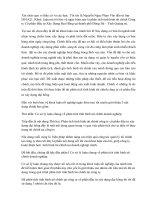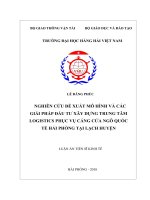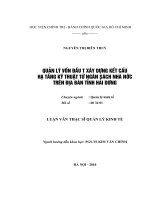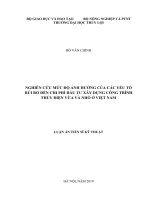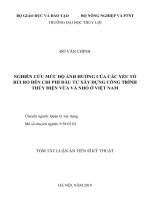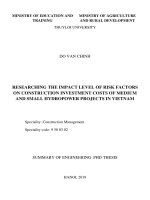CẤU TRÚC vốn VÀ cấu TRÚC KỲ HẠN nợ CỦA CÁC DOANH NGHIỆP đầu TƯ XÂY DỰNG, KINH DOANH bất ĐỘNG SẢN TẠI VIỆT NAM tt tiếng anh
Bạn đang xem bản rút gọn của tài liệu. Xem và tải ngay bản đầy đủ của tài liệu tại đây (734.51 KB, 62 trang )
MINISTRY OF EDUCATION & TRAINING
STATE BANK OF VIETNAM
BANKING UNIVERSITY HO CHI MINH CITY
PHAM THI VAN TRINH
CAPITAL STRUCTURE AND DEBT
MATURITY STRUCTURE OF REAL ESTATE
CONSTRUCTION INVESTMENT AND
TRADING ENTERPRISES IN VIETNAM
SUMMARY OF PHD THESIS
HO CHI MINH CITY – 2/2020
MINISTRY OF EDUCATION & TRAINING
STATE BANK OF VIETNAM
BANKING UNIVERSITY HO CHI MINH CITY
PHAM THI VAN TRINH
CAPITAL STRUCTURE AND DEBT
MATURITY STRUCTURE OF REAL ESTATE
CONSTRUCTION INVESTMENT AND
TRADING ENTERPRISES IN VIETNAM
SUMMARY OF PHD THESIS
Major: Finance - Banking
Code: 9 34 02 01
Scientific instructor: Assoc. Prof., PhD. Tran Hoang Ngan
PhD. Vu Van Thuc
HO CHI MINH CITY – 2/2020
1
INTRODUCTION
1. RATIONALE
1.1 Research issues
Corporate capital structure and debt maturity have certain
influences on its sustainable development as well as business
performances. It is noted that the improper choice of capital structure
and debt maturity structure that do not match characteristics of the
business sector or individual enterprise features can generally lead to
the firm’s long-term disadvantages.
As a typical feature of the business sector, real estate products are
special goods with high value and fixed location, all real estate related
activities are governed by the legal system of the country. In Vietnam,
the Land Law that marked the birth of its real estate market was just
officially launched in 1993. The fact shows that Vietnam has just got
initial steps in the real estate industry. It has suffered unstable periods
of development; sometime, it may achieve "overheating" growth then
fall into a state of "freezing". At each of the above development stage,
real estate businesses commonly face certain obstacles and difficulties.
As another feature of real estate industry, real estate businesses require
long-term funding to finance real estate projects. However, most real
estate businesses use short-term liabilities, later resulting in several
risks and obstacles for businesses’ performances regarding the pressure
of liquidity and other financial difficulties.
2
In the period from 2008 to 2017, real estate businesses had faced
various difficulties under objective impacting factors stemming from
the global financial crisis in 2008, as well as subjective ones regarding
the decision of capital structure and structure of debt maturity. It is
noted that the majority of real estate businesses heavily depends on
funding - mostly are short-term debts to invest in priority areas. Real
estate projects require capital in the long run; therefore, many real
estate businesses are currently facing large inventories, high financial
costs resulting in financial imbalance, reduced profitability and low
liquidity.
For this reason, it is critical that real estate businesses select an
effective capital structure and structure of debt maturity so that they
can achieve goals in terms of saving capital costs, taking advantage of
financial leverage, improving financial capacity, ensuring liquidity and
gaining high profitability when getting unstable signals of the real
estate market. This research, therefore, mainly addresses the following
issues: (i) factors affecting capital structure and structure of debt
maturity of real estate enterprises including performances of
construction, investment and trading in Vietnam; (ii) the speed
adjustment of capital structure and structure of debt maturity of real
estate enterprises including performances of construction, investment
and trading in Vietnam in order to achieve the target capital structure
and target debt maturity structure; (iii) determining the target capital
structure threshold and target structure of debt maturity of construction,
3
investment and trading real estate businesses in Vietnam; (iv) the
correlation between capital structure and debt maturity structure of
construction investment and trading real estate enterprises in Vietnam,
and proposes implications that construction, investment and trading
real estate businesses in Vietnam can use to decide proper capital
structure and structure of debt maturity reasonably, contributing to
improve the efficiency of the financial management and enhance the
market value.
1.2 Overview of related studies and scientific gaps
Practically, there have been several published studies related to
capital structure and structure of debt maturity carried out in different
approaches and methods worldwide generally and in Vietnam
particularly; therefore, research results differ as the follow:
Firstly, researches on capital structure of enterprises mainly focus
on large-scale enterprises that have been listed on stock exchanges in
developed countries such as France, the USA, Germany, Japan, the UK
and Switzerland including studies carried out by Rajan & Zingales
(1995), Booth & et al (2001), Graham & Harvey (2001), etc. while
others conducted in some emerging markets: China and India by Chen
(2003), Deesomsak & et al (2004), Li (2010), and Ramzi & Tarazi
(2013). In Vietnam, amongst studies on factors affecting the capital
structure are those of Doan Ngoc Phi Anh (2010), Duong Thi Hong
Van (2014) and Vo Thi Quy (2014).
4
Secondly, it is noted that studies on adjustment speed of capital
structure towards the target capital structure threshold mainly analyze
the impact of macro factors on adjustment speed of capital structure
towards the target capital structure threshold such as worldwide studies
conducted by Drobert & Wanzenried (2006), Cook & Tang (2010),
Mukkherjee & Mahakid (2012), Ahmad & Abdullah (2012). In
Vietnam, Tran Hung Son (2013) and Le Dat Chi (2013) mainly studies
the adjustment speed of dynamic capital structure; whereas Dang Thi
Thuy Anh & et al (2014) focuses on adjustment speed of static capital
structure. Furthermore, Pham Tien Minh & et al (2015) researches on
comparing the adjustment speed of static capital structure versus
dynamic one, Tran Thi Kim Oanh (2018) carries out a study on the
adjustment speed of enterprise capital structure during the global
financial crisis in 2008.
Thirdly, researches on debt maturity structure of enterprises focus
on verifying and explaining factors affecting the decision to choose
debt maturity structure of enterprises, as of Barnea & et al (1980),
Brick & Ravid (1985), Flannery (1986), Lewis (1990), Barclay &
Smith (1990), Diamond (1991), Stohs & Mauer (1996), and Ooi
(1999). Most of these studies have focused on the structure of corporate
debt maturities in developed countries. Focusing on businesses listed
on the stock exchange in Vietnam, thesis of Nguyen Thanh Nha (2018)
is the only research that has been found.
5
Fourthly, studying on the speed of adjustment of debt maturity
structure towards the target debt maturity structure threshold include
research of Leland (1994), Leland & Toft (1996) and Leland (1998),
Ozkan (2000), and Antoniou & et al (2006).
Field researches show the existence of research gaps as the
followings:
(i) Research gaps on capital structure. Previous studies have not
considered all factors, especially institutional ones-in emerging
economies due to the fact that institutional factors can influence
business capital structure, not to mention that measurement criteria if
have not been wisely chosen might lead incorrect research results that
do not truly reflect the business performances. In addition, there are a
number of works approaching in the direction of determining the target
capital structure adjustment speed, namely Antoniou & et al, 2008;
Sbeiti, 2010; Nor & et al, 2011; Tongkong & et al, 2013; Jindrichovska
& et al, 2013; Öztekin, 2015; Khanna & et al, 2015. Nevertheless, not
many researches with the above approach have been conducted in
Vietnam up to now. Specially, none of official study is carried out to
determine the target capital structure of the real estate industry. This is
the research gaps of the thesis.
(ii) Research gaps on debt maturity structure. Domestic and
abroad empirical studies on debt maturity structure still have
some shortcomings as those on capital structure. According to the
author's statistics, none published paper conducted abroad on the
6
determination of the target debt maturity structure while in Vietnam,
only study of Nguyen Thanh Nha (2018) focusing on factors affecting
the structure of debt maturity is found. As a matter of fact, there have
not been many studies on determining the target debt maturity
structure, specially the structure of debt maturity of the real estate
industry, implying that debt maturity structure of enterprises is actually
quite a new topic, which is still another research gap to be exploited
and supplemented for previous studies.
(iii) Research gaps on the correlation between capital
structure and debt maturity structure. It is recognized that a few
studies on the correlation between capital structure and debt maturity
structure have been done worldwide such as Antoniou & et al, 2006;
Teruel & Solano, 2007; Cai & et al, 2008; Deesomsak et al, 2009;
Correia and et al, 2014; Lemma & Negash, 2012; Mateurs & Terra,
2013; Costa & et al, 2014, but none has been found in Vietnam.
Therefore, it is critically important to study the correlation between
capital structure and debt maturity structure in Vietnam in order to
carry out tests based on the signaling theory and to provide empirical
evidences on whether negative or positive direction of the correlation
between capital structure and debt maturity structure in real estate
businesses in Vietnam are revealed.
The above research gaps should be certainly fulfilled in further
research on capital structure and structure of debt maturity of
enterprises in real estate industry. Acknowledging that the research
7
issue is not only theoretically but also practically important, the author
has conducted a thesis entitled “Capital structure and debt maturity
structure of construction investment and trading enterprises in
Vietnam”.
2. RESEARCH OBJECTIVES AND QUESTIONNAIRES
2.1 Objectives of the thesis
The thesis sets out following specific objectives:
(i)
To analyze factors affecting capital structure and structure of
debt maturity of real estate constructioninvestment and
trading enterprises listed on Vietnam's stock market.
(ii) To determine the adjusting speed to achieve the target capital
structure and debt maturity structure of real estate investment
and construction enterprises listed on Vietnam's stock market.
(iii) To study the correlation between capital structure and debt
maturity structure of real estate investment construction and
trading enterprises listed on Vietnam's stock market.
(iv) To identify the target capital structure and debt maturity
structure of real estate construction investment enterprises
listed on Vietnam's stock market.
2.2 Research questionnaires
(1) What are factors influencing capital structure and debt
maturity structure of real estate construction investment and
trading enterprises listed on Vietnam's stock market?
8
(2) What is the exact figure of adjusting speed of target capital
structure and structure of debt maturityof real estate
investment construction and trading enterprises listed on
Vietnam's stock market?
(3) Does the correlation between capital structure and debt
maturity structure exist?
(4) Do the target capital structure and debt maturity structure
thresholdsexist in listed construction investment and trading
enterprises in Vietnam? What is the figures of the target
capital structure and debt maturity structurethresholds?
3. RESEARCH SUBJECTIVE AND SCOPE OF THE THESIS
3.1 Research subjective
The thesis identifies capital structure and structure of debt
maturity of real estate construction investment and trading enterprises
in Vietnam. In particular, capital structure is determined by long-term
debts to total assets of the enterprise; structure of debt maturity can
be identified based on the ratio of long-term debts to total debts. There
has been no differentiation between appropriated debts and loan
among real estate investment construction and trading enterprises in
Vietnam, so long-term debts mentioned earlier can be understood as
debts with incurred interest expenses. Beside that, the thesis studies
the correlation between capital structure and debt maturity structure
9
of real estate construction investment and trading enterprises in
Vietnam.
3.2 Scope of the research
The thesis uses balance sheet data collected from financial
statements of 70 real estate construction investment and trading
businesses listed on Vietnam's stock market from 2008 to 2017. It is
emphasized that these companies had been adequately recording data
from 2008 to 2017 (70 x 10 = 700 observations) and they were all in
operation during the research period. The relevant information is
public on websites of Hanoi Stock Exchange (HNX) and Ho Chi
Minh City Stock Exchange (HOSE). Relevant Vietnamese
macroeconomic data and financial and institutional development
sources, the author collected from websites of the World Monetary
Fund (IMF), Worldbank and Datastream.
4. RESEARCH APPROACHES
By the regression method to regain balance sheet data processed
through Stata software version 14.0, the thesis is about to address the
abovequestions:
For questions (1), (2) and (3), Sys-GMM model is chosen.
For question (4), Hansen's Panel Threshold Regression model
(1999) is applied.
The qualitative research method specializing expert measures is
applied to collect comments from experts so that further implications
10
can be explained for the results of the thesis. Also, methods of content
analysis, synthesis, statistics, comparison and interpretation are
ultilized thoughout the whole thesis.
5. NEW POINTS AND CONTRIBUTIONS OF THE THESIS
5.1 Theoretically
The thesis provides evidences supporting arguments of MM
theory, agency cost theory, TOT theory, POT theory, signaling
theory, matching theory, and tax-based theory as well.
5.2 Practically
Firstly, the research sample focuses on real estate construction
investment and trading industry in Vietnam. The fact that the thesis
concentrates on a certain industry group greatly contributes to more
in-depth and solid conclusions, not mention its specific meanings to
the industry. Playing an important role in the economy, the real estate
industry highly concentrates on legal systems and macro policies
which directly or indirectly affect the market, leading to direct or
indirect impact on the capital structure as well as the decision of debt
maturity of real estate construction investment and trading enterprises
in Vietnam.
Secondly, by Sys-GMM method, quantitative research results
provide empirical evidences of which capital structure and structure
of debt maturity of real estate construction investment and trading
enterprises in Vietnam are affected by institutional factors, internal
factors and specific macro factors as the followings:
11
Institutional factors and fixed assets play a prominent role in the
decision of capital structure and debt maturity structure.
Capital structure is positively affected by internal factors
including firm size, growth rate, asset structure, and corporate income
tax whereas profitability and liquidity have negative effects on capital
structure. In addition, the study provides evidences that business risk
factors and asset maturity have little or negligible impacts on capital
structure. Also, it is shown that structure of debt maturity is strongly
affected by factors of firm size, liquidity, and business risks, but
negligibly impacted by profitability, growth opportunity, asset
maturity and corporate income tax.
Besides, capital structure is negatively affected by macro factors
including economic growth and financial development, but positively
impacted by macro factors of inflation, structure of interest rate and
financial development.
Thirdly, the research results reveal evidences of the existence of
capital structure and dynamic structure of debt maturity of real estate
construction investment and trading enterprises that adjust capital
structure and debt maturity structure towards the target threshold of
24.87% and 25.92% respectively.
Additionally, the thesis indicates solid evidences for the
existence of positive correlations between capital structure and debt
maturity structure of real estate construction investment enterprises
in Vietnam. This shows that these businesses need to reach the target
12
capital structure first, and then adjust debt maturity to achieve the
target debt maturity structure threshold.
Fourthly, the threshold model of Hansen (1999) shows
evidences of the existence of the target capital structure threshold and
debt maturity structure of real estate construction investment and
trading enterprises in Vietnam at 69.68% and 57.90% respectively.
By data filter, 40% of businesses in the research sample is found
exceeding the target capital structure threshold, and 37,14% of those
exceeding the structure of debt maturity. These figures point out
improper utilization of capital and debt maturity of real estate
enterprises in general. Some businesses have not exploited benefits
from debt balance nor debt maturity. On that basis, the author
proposes some solutions in order to help businesses to achieve the
target debt maturity structure and the capital structure threshold.
6. STRUCTURE OF THE THESIS
Chapter 1: Literature review
Chapter 2: Theoretical basis and research models
Chapter 3: Research methodology
Chapter 4: Research results and discussions on capital
structure and structure of debt maturity of real estate construction
investment and trading enterprises in Vietnam
Chapter 5: Conclusions and policy implications.
13
CHAPTER 1:
LITERATURE REVIEW
1.1 AN OVERVIEW OF EMPIRICAL RESEARCH ON
CAPITAL
STRUCTURE
AND
DEBT
MATURITY
STRUCTURE
1.1.1 Empirical research on factors impacting capital
structure and debt maturity structure
1.1.1.1 Empirical research on factors impacting capital
structure
Firstly, corporate capital structure are influenced by micro
factors including researches of Ross (1977); Titman & Wessels
(1988); Chen & et al (1997); Graham & Harvey (2001), Chen
(2003), Ramzi & Tarazi (2013), Amjad & Bilal (2012), Hunjra &
et al (2014), and Haron (2014).
Secondly, corporate capital structure are impacted by both
micro and macro factors such as macroeconomic characteristics and
development of financial markets consisting of studies by Rajan &
Jingales (1995); Wald (1999); Booth & et al (2001), Fama & French
(2002), Hatzinikolaou & et al (2002), Chen (2003), Saylgan & et al
(2006), Delcoure (2007), Fran & Goyal (2007); Jong & et al (2008),
Kayo & Kimura (2011), Gungoraydinoglu & Öztekin, (2011), Erel
& et al (2012), Drobetz & et al (2012).
14
Thirdly, many researches focus on the impacts of businessspecific and industry-specific factors on capital structure such as
Clayton, 2009; Kayo & Kmura, 2011; Andani & et al, 2012.
Fourthly, studies on institutional factors influencing capital
structure are ofProwse (1990), Rajan & Jingales (1995), DemirgucKunt & Maksimovic (1996; 1999), Deesomsak & et al (2004), Duan
& et al (2012), Öztekin & Flanery (2012), Nurlayli & et al (2013),
and Bernado & et al (2018).
1.1.2.2 Empirical research on factors impacting debt maturity
structure
Firstly, researches focusing on micro factors impacting corporate
debt maturity structure include Barnea & et al (1980); Brick & Ravid
(1985); Flannery (1986), Ooi (1999); Ozkan (2000); Teruel & Solano
(2007); Terra (2011); Mateurs & Terra (2013); Costa & et al (2014),
Hussain & et al (2018).
Secondly, researches concentrating on micro and macro factors,
institution, law or size of financial market and corporate income tax
system, which influences corporate debt maturity structure consist of
Demirguc-Kunt & Maksimovic (1999), Antoniou & et al (2006), Cai &
et al (2008), Deesomsak & et al, (2009), Wang & et al (2010), Lemma
& Negash (2012), Fan & et al (2012), Kirch & Terra (2012), Duan & et
al (2012), Lemma & Negash (2012), Correia & et al (2014).
1.1.2 Empirical studies on adjustment speed of capital structure
and debt maturity structure
15
1.1.2.1 Empirical studies on adjustment speed of capital
structure
Previous studies show several different points of view on the
behaviors of adjusting capital structure towards the target as below:
Research representing the point of view in which businesses from
the same industry have different adjustment on the target capital
structure include Ozkan (2001); Fama & French (2002); Baker
&Wurgler (2002); Welch (2004), Leary & Robert (2005), Gonzalez &
Gonzalez (2008), Haron (2014).
Research indicating the point of view in which the adjusting speed
of the target capital structure is different from industries to industries
comprise Banerjee & et al (2004); Stoja & Tucker (2007); Byoun
(2008); Wang & et al (2010); Khanna & et al (2015).
Research focusing the point of view in which the adjusting speed
of the capital structure is different from nations to nations consist of
Shyam-Sunder & Myers (1999); Fama & French (2002); Faulkender &
et al (2008); Antoniou & et al (2008); Hovakimian & Li (2009); Nor&
et al (2011); Öztekin (2015).
1.1.2.2 Empirical studies on debt maturity structure adjustment
speed
Structure of corporate debt maturity is dynamic and it shows
speed of adjustment of debt maturity structure towards the threshold
of the target debt maturity structure on three aspects as below:
16
(i) Heterogeneity among enterprises in the same industry with
speed of adjustment of debt maturity structure (Myers & Majluf,
1984; Myers, 1984; Titman & Wessels, 1988; Flannery & Rangan,
2006; Titman & Tysplakov, 2007; Flannery & Hankin, 2007; Dang,
2011).
(ii) Heterogeneity among industries with speed of adjustment
of debt maturity structure (Barclay & Smith, 1995; Ozkan, 2000;
Cai & et al, 2008).
(iii) Heterogeneity among countries with speed of adjustment
of debt maturity structure (Antoniou & et al., 2006; Deesomsak &
et al., 2009; Mateurs & Terra, 2013; Hussain & et al, 2018).
1.1.3 Empirical studies on the target capital structure and debt
maturity structure
1.1.3.1 Empirical studies on the target capital structure
Studies determining the existence of the target capital structure
of domestic and foreign enterprises mostly follow two below
approaches:
(i) By nation, Cheng & et al (2010), Ahmad & Abdullah
(2012); Wang & Zhu (2014) are recorded.
(ii) By industry and firm size, Nieh & et al (2008); and Haron
(2014) are found.
17
1.1.3.2 Empirical studies on the target debt maturity structure
The author has recorded that the target debt maturity structure
is still ignored not only in foreign countries but also in Vietnam.
Only a research of Ju & Hui (2006),examining the hypothesis of
trade-off theory to determine the optimal capital structure and debt
maturity structure of large-scale commercial companies in the US
with 1-6 year corporate bonds issuance is conducted.
1.1.4 Empirical research on the correlation between capital
structure and debt maturity structure
Research on the correlation between capital structure and debt
maturity structure in three below directions:
Firstly, capital structure has positive effects on debt maturity
structure.
Secondly, capital structure has positive or negative influences
on debt maturity structure.
Thirdly, capital structure has little or no impacts on debt
maturity structure.
1.2
RESEARCH
BACKGROUND
ON
REAL
ESTATE
ENTERPRISES IN VIETNAM
1.2.1 Characteristics of real estate industry in general and real
estate enterprises in Vietnam
1.2.1.1 Characteristics of real estate industry in Vietnam
18
Real estate industry is influenced by industry factors
contributing to the decision of real estate corporate capital structure
and debt maturity structure as follows:
Firstly, it is noted real estate products have great value, which
is an outstanding characteristics of the industry. Therefore, it is a
must to identify corporate capital structure and debt maturity
structure following business cycles of the real estate industry,
which are likely to be longer than commercial and service ones.
Secondly, real estate is considered as one of the most
competitive industries. It is no doubt that its special products need
a sufficiently large capital in order to launch projects. Thus,
management experience, reputation in the market, and ability to
operate and to penetrate the market are decisive factors for
enterprises to compete top positions of the market.
Thirdly, the ability to access funding in order to run real estate
businesses is limited. The majority of capital is short-term loans
from commercial banks.
Fourthly, the real estate industry is governed by real estate
institutions. The fact that the real estate market is quite young, plus
real estate institutions are gradually improving with lots of constant
changes and adjustments, is actually an indirect obstacle for
businesses to implement capital structure and to decide structure of
debt maturity so that corporate value can be increased in the market.
19
1.2.1.2 Characteristics of real estate businesses in Vietnam
Enterprises in real estate industry have different characteristics
compared to those in other fields:
Firstly, it is size of the business. Large and reputable
enterprises in the market are easier to access to low-cost capital
sources and less subject to liquidity pressure. They are also able to
increase business efficiency better than small and medium-sized
enterprises.
Secondly, it is type of the enterprise in real estate industry and
business sector that decides real estate corporate capital structure
and structure of debt maturity in Vietnam.
Thirdly, investment cost of fixed assets is another feature to be
mentioned. It is obvious that fixed assets of real estate enterprises
are projects, and it certainly requires very huge costs.
Fourthly, it is tax incentives. They show that corporate income
tax also has a significant impact on capital structure and debt
maturity structure of real estate businesses.
1.2.2 Current situation of capital structure, debt maturity
structure and financial objectives of real estate construction
investment and trading enterprises in Vietnam
1.2.2.1 Current situation of capital structure and debt maturity
structure of real estate construction investment and trading
enterprises in Vietnam
20
1.2.2.2 Current situation of financial objectives of real estate
construction investment and trading enterprises in Vietnam
CHAPTER 2
THEORETICAL FRAMEWORK OF CAPITAL STRUCTURE
AND DEBT MATURITY STRUCTURE OF ENTERPRISES
2.1. THEORETICAL FRAMEWORK OF CAPITAL
STRUCTURE AND DEBT MATURITY STRUCTURE OF
ENTERPRISES
2.1.1 Theoretical basis of capital structure
The thesis presents an overview of the applied theories:
- Modilligiani and Miller theory;
- Agency cost theory;
- Trade-off theory (TOT);
- Pecking Order theory (POT).
2.1.2 Theoretical basis of debt maturity structure
The thesis presents an overview of the theories applied in the
thesis.
- Modilligiani and Miller theory;
- Trade-off theory (TOT);
21
- Signaling theory;
- Tax-based theory;
- Matching theory.
The mentioned theories of capital structure and debt maturity
structure have different points of view; however, they do not replace
but complement each other, contributing to a better decision of funding
sources.
2.2
THEORETICAL
REVIEW
AND
EMPIRICAL
RESEARCHES ON CAPITAL STRUCTURE AND DEBT
MATURITY STRUCTURE
2.2.1 Theoretical review of capital structure and debt maturity
structure
2.2.2 Review of Empirical researches on capital structure and
debt maturity structure
2.3 MODELS AND PROPOSED RESEARCH HYPOTHESIS
2.3.1 Research Hypothesis
Based on the theoretical framework of capital structure and debt
maturity structure, the thesis builds hypotheses to study the capital
structure and debt maturity structure of listed real estate construction
investment and trading enterprises listed in Vietnam in model 1
(capital structure) and model 2 (debt maturity structure)as follows:
22
Table 2.2 Review of research hypotheses
Variable
Theory
Hypothesis
Model 1
Emperial research
Model 2
Interest term
Modilligiani and
structure
Miller theory; Tax-
(TERM)
based theory
et al (2014), Deesomsak & et al (2009)
Economic
Characteristics of
Lemma and Negash (2012), Wang & et
growth
the market
al (2010), Deesomsak & et al (2009),
(GDP)
Antoniou & et al (2006), Cai & et al
(+)
(+)
(+)
(+)
(2008), Cook & Tang (2010), Correia &
Fan & et al (2012), Alves & Francisco
(2015).
Inflation
(INF)
(+)
(+)
Financial
development
(FD)
Deesomsak & et al (2009); Wang & et al
(2010), Fan & et al (2012).
Krich & Terra (2012), Fan & et al
(+)
(+)
(2012), Lemma &Negash (2012), Alves
23
and Francisco (2014), Correia & et al
(2014).
Country
Prowse (1990), Demirguc - Kunt &
Policy and
Maksimovic (1999), Deesomsak & et al
Institution
(2004), Öztekin & Flanery (2012), Fan
Assessment
(+)
(+)
(CPIA)
& et al (2012), Lemma & Negash
(2012), Krich & Terra (2012), Duan &
et al (2012), Alves & Francisco (2015),
Bernardo & et al (2018)
Return
of Signaling theory
Total Equity
(ROE)
Deesomsak & et al (2009), Fan & et al
(-)
(-)
(2012),
Kirch
&
Terra
(2012),
Mateurs& Terra (2013), Correia & et al
(2014)
